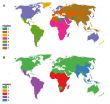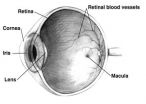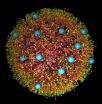(Press-News.org) Researchers at North Carolina State University have for the first time mapped human disease-causing pathogens, dividing the world into a number of regions where similar diseases occur.
The findings show that the world can be separated into seven regions for vectored human diseases - diseases that are spread by pests, like mosquito-borne malaria - and five regions for non-vectored diseases, like cholera.
Interestingly, not all of the regions are contiguous. The British Isles and many of its former colonies, such as the United States and Australia, have similar diseases and are classified in the same vectored and non-vectored regions. But Britain's former colonies in Africa and Asia contain different diseases and therefore are located in differing regions, suggesting that colonization is just one of a variety of factors, like climate and socio-political status, affecting the prevalence of disease in a specific area.
"This is about more than just the movement of people - climate, history and geography all seem to be important factors in how diseases survive and thrive across the globe," said Michael Just, an NC State Ph.D. student in plant and microbial biology and lead author of a paper describing the research. "Understanding that not all pathogens are everywhere could have consequences for public health and the global society as a whole."
The researchers examined the world's 229 countries for the presence or absence of 301 diseases - 93 vectored and 208 non-vectored. It found two more vectored-disease regions than non-vectored disease regions, which is likely due to the fact that the vectors - the pests that carry disease - sometimes have limited mobility. Think of a warm-weather pest that can't handle the cold, like the mosquito.
"Researchers have mapped humans, animals and plants and their movement and evolution across the globe, but the things that live on or with us - pests and pathogens, for example - have been largely ignored," Just said. "This study is a good first step in examining the relationship between people and their pathogens, which could have important human health implications."
INFORMATION:
-Kulikowski
Note: An abstract of the paper follows.
"Global biogeographic regions in a human-dominated world: the case of human diseases"
Authors: Michael Just, Jacob Norton, Amanda Traud, Tim Antonelli, Aaron Poteate, Gregory Backus, Andrew Snyder-Beattie, R. Wyatt Sanders and Rob Dunn, NC State University
Published: Nov. 21, 2014, in Ecosphere
DOI: 10.1890/ES14-00201.1
Abstract: Since the work of Alfred Russel Wallace, biologists have sought to divide the world into biogeographic regions that reflect the history of continents and evolution. These divisions not only guide conservation efforts, but are also the fundamental reference point for understanding the distribution of life. However, the biogeography of human-associated species--such as pathogens, crops, or even house guests--has been largely ignored or discounted. As pathogens have the potential for direct consequences on the lives of humans, domestic animals, and wildlife it is prudent to examine their potential biogeographic history. Furthermore, if distinct regions exist for human-associated pathogens, it would provide possible connections between human wellbeing and pathogen distributions, and, more generally, humans and the deep evolutionary history of the natural world. We tested for the presence of biogeographic regions for diseases of humans due to pathogens using country-level disease composition data and compared the regions for vectored and non-vectored diseases. We found discrete biogeographic regions for diseases, with a stronger influence of biogeography on vectored than non-vectored diseases. We also found significant correlations between these biogeographic regions and environmental or socio- political factors. While some biogeographic regions reflected those already documented for birds or mammals, others reflected colonial history. From the perspective of diseases caused by pathogens, humans have altered but not evaded the influence of ancient biogeography. This work is the necessary first step in examining the biogeographic relationship between humans and their associates.
Good news on the panda front: Turns out they're not quite as delicate - and picky - as thought.
Up until now, information gleaned from 30 years worth of scientific literature suggested that pandas were inflexible about habitat. Those conclusions morphed into conventional wisdom and thus have guided policy in China. But a Michigan State University (MSU) research associate has led a deep dive into aggregate data and emerged with evidence that the endangered animal is more resilient and flexible than previously believed.
Vanessa Hull is a postdoctoral research associate ...
Irvine, Calif., Dec. 3, 2014 - High fecal counts frequently detected at so-called "baby beaches" may not be diaper-related. UC Irvine researchers found that during summer months, small drainpipes emptying into enclosed ocean bays have a disproportionate impact on calmer waters. The findings were published Tuesday in the journal Environmental Science & Technology.
Researchers have long known that creeks and tributaries foul coastal waters with major winter storm runoff. But dry seasons like the one that just concluded can spell potential peril, too. Runoff from watering ...
When it comes to getting out of a tricky situation, we humans have an evolutionary edge over other primates. Take, as a dramatic example, the Apollo 13 voyage in which engineers, against all odds, improvised a chemical filter on a lunar module to prevent carbon dioxide buildup from killing the crew.
UC Berkeley scientists have found mounting brain evidence that helps explain how humans have excelled at "relational reasoning," a cognitive skill in which we discern patterns and relationships to make sense of seemingly unrelated information, such as solving problems in unfamiliar ...
Scientists have developed a new light-sensitive film that could one day form the basis of a prosthetic retina to help people suffering from retinal damage or degeneration. Hebrew University of Jerusalem researchers collaborated with colleagues from Tel Aviv University and Newcastle University in the research, which was published in the journal Nano Letters.
The retina is a thin layer of tissue at the inner surface of the eye. Composed of light-sensitive nerve cells, it converts images to electrical impulses and sends them to the brain. Damage to the retina from macular ...
A new research brief from the US2010 Project probes the status of minorities in American suburbs. Suburbs in 2010 were as racially and ethnically diverse as were central cities in 1980, and that diversity is still increasing. Yet minorities are not finding equal access to the American dream in the suburbs where they live, a lesson illustrated recently by Ferguson, MO.
Suburbia has always been less segregated than central cities. Segregation is slowly declining between suburban blacks and whites, but has stayed about the same for Hispanics and Asians over three decades. ...
Do you consider yourself a conscientious person? Then sign up for a fixed-rate mortgage. Neurotic? You'll probably opt for home ownership over renting.
According to a new study published in the Journal of Behavioral and Experimental Economics, personality traits are strong indicators of real-estate decisions. The research, by Dr. Danny Ben-Shahar of Tel Aviv University's Faculty of Management and doctoral candidate Roni Golan of the Technion Institute of Technology, finds a correlation between personality and individual real estate choices, and a follow-up study by the ...
Those wishing to prove themselves as "doers" must not only be hands-on and demonstrate proactive behavior but also have social acumen and a feel for favorable opportunities. Those who rely on personal initiative alone will quickly be standing there as an isolated troublemaker. This is what psychologists from the University of Bonn and their colleagues from Florida State University (USA) have discovered through surveying a variety of occupational categories. The results have been published online in the renowned "Journal of Management". The printed version will be published ...
Learning from others and innovation have undoubtedly helped advance civilization. But these behaviours can carry costs as well as benefits. And a new study by an international team of evolutionary biologists sheds light on how one particular cost - increased exposure to parasites - may affect cultural evolution in non-human primates.
The results, published Dec. 3, 2014, in the journal Proceedings of the Royal Society B, suggest that species with members that learn from others suffer from a wider variety of socially transmitted parasites, while innovative, exploratory ...
This news release is available in German.
(Jena/Germany) Jena scientists have been successful in producing highly specific nanoparticles. Depending on the bound dye the particles are guided to the liver or to the kidney and deliver their payload of active ingredients directly to the targeted tissue. Moreover, the dyes enable the tracking of the transport processes by intravital microscopy or, in a non-invasive way, by multi spectral optoacoustic tomography. The reduction of cholesterol production induced by siRNA served as the proof-of-principle for the developed ...
What do lasers, neural networks, and spreading epidemics have in common? They share a most basic feature whereby an initial pulse can propagate through a medium - be it physical, biological or socio-economic, respectively. The challenge is to gain a better understanding - and eventually control - of such systems, allowing them to be applied, for instance to real neural systems. This is the objective of a new theoretical study published in EPJ B by Clemens Bachmair and Eckehard Schöll from the Berlin University of Technology in Germany. Ultimately, with a better theoretical ...



